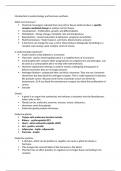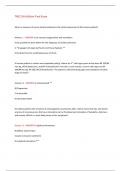Introduction to endocrinology and hormone synthesis.
What are hormones?
Chemical messengers released from one cell (or tissue) which produce a specific,
receptor-mediated change in another cell (or tissue).
Development - Proliferation, growth, and differentiation
Metabolism - Energy storage, metabolic rate and temperature.
Reproduction - Sexual maturation & behaviour, pregnancy & lactation.
Fluid homeostasis - Water balance, salt levels, blood volume, pressure
A hormone can change the way a cell or tissue behaves biologically by binding to a
receptor and causing a post receptor series of events.
Is endocrinology important?
Insulin-used to treat diabetes is a hormone
Thyroxine- used to treat hypothyroxism is a modified form of a hormone.
Contraceptive pill- contains either progesterone or progesterone and oestrogen. Can
be used as a contraceptive pill or to help with endrometriosis.
Hormone replacement therapy is used for women undergoing menopauses it
delivers hormones that are no longer present.
Androgen blockers- compounds that can block a hormone. They are not a hormone
themselves but they block the androgen receptor. This is really important in diseases
like prostate cancer. Because some forms of prostate cancer are driven by
testosterone. So if you block the testosterone receptor you block the proliferation of
cancer.
Steroids-
Glands.
• A gland is an organ that synthesises and releases a substance into the bloodstream,
body cavity or skin.
• Glands can be, endocrine, exocrine, mucous, serous, sebaceous.
• Hormones come from glands.
• Endocrine glands produce hormones.
Endocrine glands
Tissues with endocrine function include:
Kidney – erythropoietin (EP)
Heart - atrial natriuretic peptide (ANP)
Gut - gastrin, secretin
Adipocytes - leptin, adiponectin
Pancreas - insulin
Endocrine systems.
A stimulus, which can be positive or negative can cause a gland to release a
hormone.
This changes the concentration of the hormone in the blood.
This then has an effect (positive or negative) on its target tissue via binding to its
receptor.
, Then we see some form of cellular action.
Then there is some feedback from a hormone and this stops the gland from
producing the previous hormone.
These two hormones can be the same. And what you get is negative feedback.
Cell-to-cell communication via hormones.
How do cells communicate to each other via hormones:
There are 4 pathways:
autocrine: cell A releases a hormone and that hormone binds to a receptor on cell A.
this causes an effect. So the target is the same cell that releases a hormone. Eg.
Pancreatic Beta cells which are found in the islets of Langerhans in the pancrease
because they produce insulin but they also have an insulin receptor on their plasma
membrane and the cells do not function properly if the insulin recptor is not there so
the autocrine role of insulin is important.
Paracrine: a hormone is released from cell A and it has an effect on a neighbouring
cell, cell B. Eg. Pancreatic islets where stomatostatin which is released by the delta
cells of the pancrease inhibits insulin secretion by the Beta cells by binding to the
stomatostatin receptor.
Endorcirne: the secretory cell A releases a hormone which gets secreted into the
blood. This circulates around the body to find a distant cell with a receptor, cell B.
hormone binds to cell B receptor and causes a response. It involves the blood
stream.
Neurocrine: a hormone is produced in a neurone, it is passed down the long axon of
that neurone and then it is released into the bloodstream to have an effect on cell B.
Hormone synthesis.
2 major classes of hormones:
Steroid hormones
Protein and peptide hormones
Peptide hormones:
As these are proteins they need to be transcribed from the DNA that is found in the
nucleus.
DNA is reverse transcribed into mRNA and the mRNA is translated at the RER to
produce a sequence of amino acids, which then get post translationally processed
and packaged in the golgi apparatus into secretory vesicles to be exocytosed from
the cells.
Steroid hormones:
There is a precursor molecule for all steroid hormones. They do not come from
genes and they do not have to be transcribed or translated.
They come from hydrolysis of esters and release of cholesterol.
Cholesterol is the precursor molecule for all steroid hormones and cholesterol is
converted into proglananol and this gets converted into a whole range of steroid
hormones which can diffuse out of the cell because they are lipid molecules.
Peptide hormones.
Peptide hormones are synthesised from amino acids and are typically:
Processed in several stages
What are hormones?
Chemical messengers released from one cell (or tissue) which produce a specific,
receptor-mediated change in another cell (or tissue).
Development - Proliferation, growth, and differentiation
Metabolism - Energy storage, metabolic rate and temperature.
Reproduction - Sexual maturation & behaviour, pregnancy & lactation.
Fluid homeostasis - Water balance, salt levels, blood volume, pressure
A hormone can change the way a cell or tissue behaves biologically by binding to a
receptor and causing a post receptor series of events.
Is endocrinology important?
Insulin-used to treat diabetes is a hormone
Thyroxine- used to treat hypothyroxism is a modified form of a hormone.
Contraceptive pill- contains either progesterone or progesterone and oestrogen. Can
be used as a contraceptive pill or to help with endrometriosis.
Hormone replacement therapy is used for women undergoing menopauses it
delivers hormones that are no longer present.
Androgen blockers- compounds that can block a hormone. They are not a hormone
themselves but they block the androgen receptor. This is really important in diseases
like prostate cancer. Because some forms of prostate cancer are driven by
testosterone. So if you block the testosterone receptor you block the proliferation of
cancer.
Steroids-
Glands.
• A gland is an organ that synthesises and releases a substance into the bloodstream,
body cavity or skin.
• Glands can be, endocrine, exocrine, mucous, serous, sebaceous.
• Hormones come from glands.
• Endocrine glands produce hormones.
Endocrine glands
Tissues with endocrine function include:
Kidney – erythropoietin (EP)
Heart - atrial natriuretic peptide (ANP)
Gut - gastrin, secretin
Adipocytes - leptin, adiponectin
Pancreas - insulin
Endocrine systems.
A stimulus, which can be positive or negative can cause a gland to release a
hormone.
This changes the concentration of the hormone in the blood.
This then has an effect (positive or negative) on its target tissue via binding to its
receptor.
, Then we see some form of cellular action.
Then there is some feedback from a hormone and this stops the gland from
producing the previous hormone.
These two hormones can be the same. And what you get is negative feedback.
Cell-to-cell communication via hormones.
How do cells communicate to each other via hormones:
There are 4 pathways:
autocrine: cell A releases a hormone and that hormone binds to a receptor on cell A.
this causes an effect. So the target is the same cell that releases a hormone. Eg.
Pancreatic Beta cells which are found in the islets of Langerhans in the pancrease
because they produce insulin but they also have an insulin receptor on their plasma
membrane and the cells do not function properly if the insulin recptor is not there so
the autocrine role of insulin is important.
Paracrine: a hormone is released from cell A and it has an effect on a neighbouring
cell, cell B. Eg. Pancreatic islets where stomatostatin which is released by the delta
cells of the pancrease inhibits insulin secretion by the Beta cells by binding to the
stomatostatin receptor.
Endorcirne: the secretory cell A releases a hormone which gets secreted into the
blood. This circulates around the body to find a distant cell with a receptor, cell B.
hormone binds to cell B receptor and causes a response. It involves the blood
stream.
Neurocrine: a hormone is produced in a neurone, it is passed down the long axon of
that neurone and then it is released into the bloodstream to have an effect on cell B.
Hormone synthesis.
2 major classes of hormones:
Steroid hormones
Protein and peptide hormones
Peptide hormones:
As these are proteins they need to be transcribed from the DNA that is found in the
nucleus.
DNA is reverse transcribed into mRNA and the mRNA is translated at the RER to
produce a sequence of amino acids, which then get post translationally processed
and packaged in the golgi apparatus into secretory vesicles to be exocytosed from
the cells.
Steroid hormones:
There is a precursor molecule for all steroid hormones. They do not come from
genes and they do not have to be transcribed or translated.
They come from hydrolysis of esters and release of cholesterol.
Cholesterol is the precursor molecule for all steroid hormones and cholesterol is
converted into proglananol and this gets converted into a whole range of steroid
hormones which can diffuse out of the cell because they are lipid molecules.
Peptide hormones.
Peptide hormones are synthesised from amino acids and are typically:
Processed in several stages




